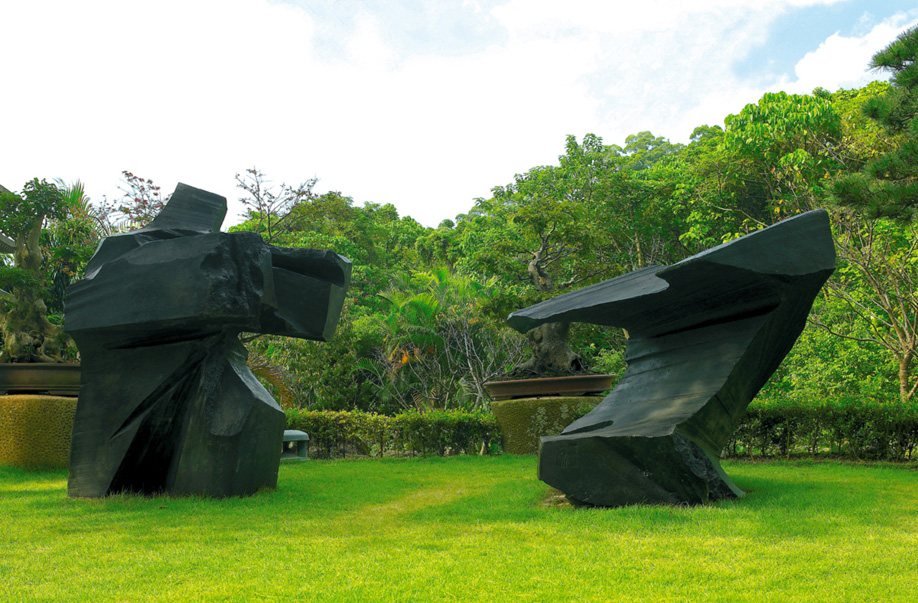|
Taichi Shadow Boxing
|
|
1984 Bronze 117.5(L) x 89.5(W) x 150.7(H) cm (Left) Signed Ju Ming in Chinese and English, dated '84 |
|
Estimate
22,000,000 - 30,000,000 5,239,000 - 7,143,000 672,800 - 917,500
|
|
Sold Price
27,090,000 6,554,561 838,181
|
|
|
Spatial Signs of Humanity's Wisdom
Text/ Li Chiao
In Chinese contemporary art, Ju Ming's sculpture art is famous for "sculpture style for the connotation of profound Oriental culture and unique characteristics."In his sculptures of the Taichi Series, from individual works to surrounding environments, a unique human landscape structure is thoroughly developed. The reason why such a kind of human landscape attracts the artist is that the possibility of many forms of a new style derived from the original exists in Chinese imagery which is regarded as a common artistic main topic. Thus, with perceptiveness towards the whole humanistic environment of such kind of landscape, Ju, in his creation of a formalistic language, borrows basic moves in Chinese taichichuan (meaning: 'shadowboxing' in accordance with traditional pattern elements. Then he further uses the nature of modern sculptures - of large size and heavy weight and simple surface - to replace traditional connotations. His works convey his realization of concept involving fusion and fluidity between Chinese and Western culture.
In Ju Ming's Taichi Series, the link between geometrical and abstract surfaces and figures?dynamic movements, as well as the contrast between dynamic and static states and between bulkiness and succinctness in three-dimensional spatial languages, form rich and orderly rhythms. In sunlight or shade, sculptures have different effects of great variety. The artist is immersed in the delicate transitional process of figurative and non-figurative modeling languages. Needing to rely on his own experience, understanding and judgment, he arranges people's familiarity with taichi culture and its relevant moves in an artistic manner. Then he escapes the relevant imagery structure of the past to search for a new abstract sculptural language as a reference; thus he develops out a new spatial language structure. In experiencing his artistic development from sentimental local and native feelings to taichi expression, there is a steady-effort spirit in his pursuit. Ju has a good background for carrying on tradition from his teacher, and for his own talent and diligence. For this reason, he can use the forefather's performance and further bring his potential into fuller and better play.
In Ju's creation of the Taichi Series, he references sculptures of the self and those in the environment for each other and fuses them together to introduce a new idea of modern sculpture. In a modern public space, he offers us a wider visual creation and humanistic picture. Whether in green areas of urban cities or in natural landscapes, Ju has a unique wisdom to create sculptural forms full of visual signs. To become an extension of complementary and natural creation of urban life, his works generate visual tension, using a static state to control active or dynamic states as well as having a breathtaking sense of large size and heavy weight. Thus the inspiration of specific times is shown. Also, there is boundless imagination and cultivation of the contemporary aesthetic spirit.
In fact, in the Taichi Series, there are spatial signs about which the artist possesses humanistic wisdom. The work deals with Ju's spiritual adaptation to the material world. The more profound source is that the artist is ready to offer new spatial structures with reasons and possibilities for free creation. He once regarded art as "self-meditation."The artist's sculptures in the Taichi Series perfectly represent his high-level realm of following natural laws and giving up ego and material things. Gathering in the essence of all beings of the universe - changing in every way and then returning back to ordinary life - is the profound cultural idea that creates the achievement in Ju's Taichi Series. Having already won great praise and wide attention, this work has been complimented as "involving natural charm and creative spirit."Because of the artist's profound traditional foundation and sensitive artistic insights, he chooses the image of taichi to perform his artistic transformation and make room to imagine the magical Chinese spirit and style.
